
The British L-class submarine was originally planned under the emergency war programme as an improved version of the British E-class submarine. The scale of change allowed the L class to become a separate class.
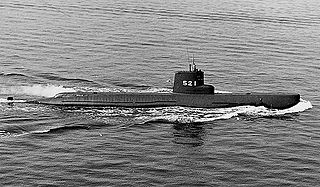
The Hayashio-class submarine was the successor design to the Japanese submarine Oyashio, and the predecessor of the Natsushio class with the Japan Maritime Self-Defense Force. Ordered in 1959, the boats were small with limited capability but were successful. Constructed in Japan from 1960 to 1962, they remained in service until 1979 when they were discarded.
The R-class submarines were a class of 12 small British diesel-electric submarines built for the Royal Navy during World War I, and were forerunners of the modern attack submarine, in that they were designed specifically to attack and sink enemy submarines, their battery capacity and hull shape being optimized for underwater performance.
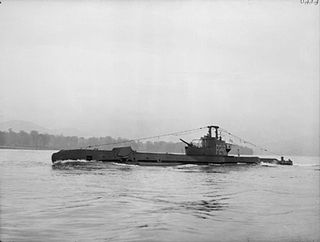
HMS Scotsman was a third-batch S-class submarine of the third batch built for the Royal Navy during World War II. After training exercises in Britain during which she ran aground, requiring repairs, she was transferred to the Pacific fleet as the war with Germany had ended. The submarine sank one junk en route to her submarine unit, but arrived after the end of the Pacific war and World War II. She was scrapped in November 1964.
HMS H34 was a British H class submarine built by Cammell Laird, Birkenhead. The vessel was laid down on 20 November 1917 and was commissioned on 10 September 1919. She had a complement of twenty-two crew members.

HMS H32 was a H-class submarine constructed for the Royal Navy. The submarine entered service in 1919 and served in the Second World War, one of only seven of the class to do so. During Warship Week 1942 H32 was adopted by Lydney RDC (Gloucestershire). The submarine was sold for scrap in 1944.
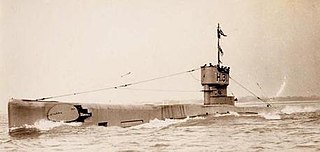
HMS H31 was a British H class submarine built by Vickers Limited, Barrow-in-Furness. She was laid down on 19 April 1917 and was commissioned on 21 February 1919.

The Balilla class were the first submarines to be built for the Italian navy following the end of World War I. They were large ocean-going cruiser submarines designed to operate in the Indian Ocean based in Italy's East African colonies. The design was double-hulled and based on the German Type UE 2 U-boats, one of which, U-120 was supplied to the Italians as a war reparation. A 425 horsepower (317 kW) auxiliary diesel engine was installed as an extra generator.
The Hrabri class consisted of two submarines built for the Kingdom of Serbs, Croats and Slovenes – Yugoslavia from 1929 on – by Vickers-Armstrong in the United Kingdom. Launched in 1927, the boats were named Hrabri (Brave) and Nebojša (Fearless). Their design was based on that of the British L-class submarine of World War I, and they were built using parts from L-class submarines that were never completed. The Hrabri-class were the first submarines to serve in the Royal Yugoslav Navy (KM), and after extensive sea trials and testing they sailed from the UK to the Adriatic coast of Yugoslavia, arriving in April 1928. They were armed with six bow-mounted 533 mm (21 in) torpedo tubes, two 102 mm (4 in) deck guns, one QF 2-pounder L/39 anti-aircraft gun and two machine guns. Their maximum diving depth was restricted to 55 metres (180 ft) by Yugoslav naval regulations.
The Osvetnik class consisted of two submarines built for the Kingdom of Serbs, Croats and Slovenes – Yugoslavia from 1929 on – by Ateliers et Chantiers de la Loire in Nantes, France. Launched in 1928 and 1929, the boats were named Osvetnik (Avenger) and Smeli (Daring). They were built to a partial double hull Simonot design similar to the French Circé-class submarines. Also known as the Smeli class, they were the second class of submarines to serve in the Royal Yugoslav Navy (KM), and after extensive sea trials and testing they sailed from France to the Adriatic coast of Yugoslavia, arriving in December 1929, where they joined the two larger British-made Hrabri-class submarines to make up the pre-war Yugoslav submarine flotilla. The Osvetnik-class were armed with six 550 mm (22 in) torpedo tubes, one 100 mm (3.9 in) gun, and one 40 mm (1.6 in) anti-aircraft gun, and could dive to 80 metres (260 ft).
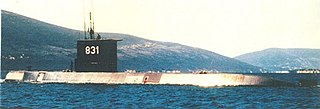
The Sava class was a class of diesel-electric attack submarines built for the Yugoslav Navy during the late 1970s and early 1980s. Developed by the Brodarski Institute (BI) from Zagreb, the two strong class was built by the Brodogradilište specijalnih objekata in Split. They were intended as a replacement for the aging Sutjeska-class submarines. Compared to the earlier Heroj class, the Sava class was longer with more powerful armament that consisted of six torpedo tubes that could also be used for minelaying.
Hrabri (Brave) was the lead boat of the Hrabri-class submarines; built for the Kingdom of Serbs, Croats and Slovenes– Yugoslavia by the Vickers-Armstrong Naval Yard in the United Kingdom. Launched in 1927, her design was based on the British L-class submarine of World War I, and was built using parts from an L-class submarine that was never completed. The Hrabri-class were the first submarines to serve in the Royal Yugoslav Navy (KM), and after extensive sea trials and testing Hrabri sailed from the UK to the Adriatic coast of Yugoslavia, arriving in April 1928. The submarine was armed with six bow-mounted 533 mm (21 in) torpedo tubes, two 102 mm (4 in) deck guns, one QF 2-pounder L/39 anti-aircraft gun and two machine guns. Its maximum diving depth was restricted to 55 metres (180 ft) by Yugoslav naval regulations.
Nebojša was the second of the Hrabri-class submarines; built for the Kingdom of Serbs, Croats and Slovenes– Yugoslavia by the Vickers-Armstrong Naval Yard in the United Kingdom. Launched in 1927, her design was based on the British L-class submarine of World War I, and was built using parts from an L-class submarine that was never completed. The Hrabri-class were the first submarines to serve in the Royal Yugoslav Navy (KM), and after extensive sea trials and testing Nebojša sailed from the UK to the Adriatic coast of Yugoslavia, arriving in April 1928. The submarine was armed with six bow-mounted 533 mm (21 in) torpedo tubes, two 102 mm (4 in) deck guns, one QF 2-pounder L/39 anti-aircraft gun and two machine guns. Its maximum diving depth was restricted to 55 metres (180 ft) by Yugoslav naval regulations.
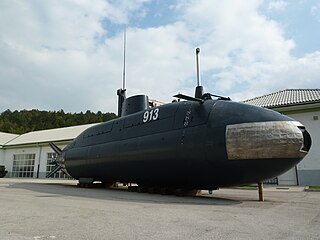
The Una-class submarine was a class of six midget submarines built for the Yugoslav Navy at the Brodogradilište specijalnih objekata during the 1980s. They were designed with the purpose of laying small minefields and transporting naval special forces, with or without their submersibles, in shallow waters that were inaccessible for larger submarines. Due to their mission profile that called for a small design as well as the need to stay undetected, they lacked torpedo armament and a generator for battery recharging.

Mališan was a CB-class midget submarine in service with the Yugoslav Navy. Mališan was laid down in 1943 as CB-20 for the Regia Marina. Following the Italian Armistice in September 1943, the unfinished boat was captured by the Germans who handed it to the Navy of the Italian Social Republic. The boat was captured by Yugoslav Partisans in Pula in 1945 and commissioned in the JRM shortly after the war.

The French submarine Mariotte (Q74) was a submarine built for the French Navy prior to World War I. Intended to accompany the fleet, she was designed for high speed on the surface. Although the navy was unsatisfied with her performance on the surface, the boat had a higher underwater speed than any French submarine before or during the following 35 years. Mariotte was plagued with engine problems during her construction and the navy spent years fixing the various issues before finally commissioning her five years after beginning construction. During the war, she participated in the Dardanelles Campaign, but had to be scuttled after she became entangled in the cables of a minefield on her first attempt to penetrate the Dardanelles.

Prairial was one of 18 Pluviôse-class submarines built for the French Navy in the first decade of the 20th century. During World War I, Priarial collided with the British steamer Tropic in the English Channel off Le Havre, France, and sank with the loss of 19 of her 26 crew.

The Uskok class was a class of two motor torpedo boats built for the Royal Yugoslav Navy during the late 1920s. Named Uskok and Četnik, the boats were built by the Thornycroft Company based on their existing class of 17-metre-long (55 ft) Coastal Motor Boats, but were almost 1.5 metres (5 ft) longer. As their main armament they were equipped with cradles that carried two British-designed 456-millimetre (18 in) torpedoes, were fitted with hydrophones, and could carry depth charges instead of torpedoes if used in an anti-submarine role. The boats were lightly-built using mahogany, powered by two petrol engines, but lacked transverse bulkheads within the hull to mitigate leaks.
Sava was a Flutto-class submarine in service with the Yugoslav Navy. Built by Cantieri Riuniti dell'Adriatico in Monfalcone during the Second World War, Sava was laid down and completed as Nautilo for service with the Italian Regia Marina.
Balilla was the lead ship of her class of four submarines built for the Regia Marina during the late 1920s.













